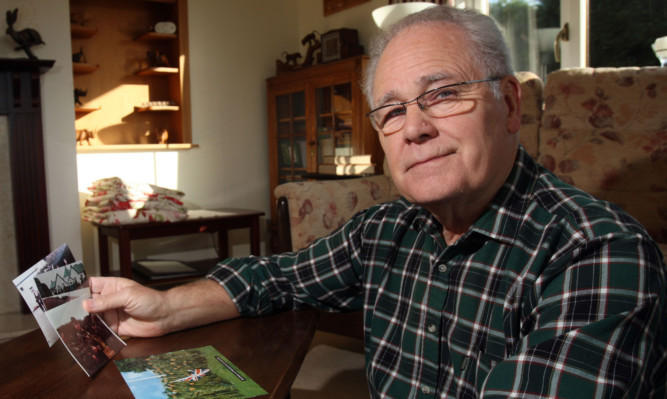The Angus marine who returned the flag of the Falkland Islands to its capital has spoken about his part in the war on the eve of the Royal Marines’ 350th anniversary.
Sergeant Major Bill Muir, 66, left 45 Commando in Arbroath to sign up for a year’s tour of duty in the Falklands as part of Naval Party 8,901 and arrived just four days before the Argentinians invaded.
The invasion on April 2 1982 took place when both British detachments were on the island but they were still vastly outnumbered by the invading force.
Mr Muir, who lives in Letham, was in charge of defending Government House, the home of the islands’ London-based governors at the edge of the capital Stanley, which was the site of a major battle during the invasion.
He said: “There had been a build-up from the previous week when the Argentinians landed a force on South Georgia.
“On April 1 we got the message that an invasion was imminent. We prepared to set up our defences around the airport and Government House.
“The Argentinians invaded in the early hours of the 2nd. We were vastly outnumbered there were a total of 79 of us across the two detachments and initially the Argentinians brought around 700 men ashore.
“They said they had another couple of thousand sitting on ships around the islands.”
Mr Muir recalled the firefight which took place under darkness, which led to the British troops becoming surrounded at Government House.
* See special coverage of the marines’ 350th anniversary in Tuesday’s Courier
“At 2am we all left our barracks at Moody Brook and the invasion started from about 4am,” he said.
“They started coming ashore in the most easterly part of the island and at 6am from the westerly part of the Island.
“I heard the explosions at the barracks, which were empty. That’s when we knew they were coming from both the east and west. We were tactically surrounded at Government House.
“We were firing off and they were firing back. Rex Hunt, the governor, gave the order to surrender to Major Mike Norman, our commanding officer, at about 9.30am.
“Government House is right on the edge of Stanley and the decision was taken to protect the civilians in the town.
“The Argentinian flag was prepared for hoisting on top of Stanley House but the rope snapped in the breeze, which was cheered by the British troops.”
Mr Muir and the other troops were captured as prisoners of war. After being rounded up, they were allowed to collect their personal kit from the barracks before being flown out at around 7.30pm that evening.
“We were actually treated with respect by the Argentinians,” Mr Muir said.
“We were flown to an airfield in Argentina and then transferred to Montevideo in Uruguay, where we stayed under house arrest for three days until we were picked up.
“I had expected to end up in prison in Argentina but they flew us to Montevideo and left us there. I think it was because it was a good bit of PR for the Argentinians.”
Mr Muir was part of a taskforce attached to 42 Commando which returned to the Islands 48 days later and took part in many battles including Goose Green, Mount Harriet and the taking of Stanley before the end of the war on June 14.
He was given the honour of putting the Falklands flag back at Stanley House.
“Major General Moore, the commander of land forces, gave our detachment the honour of replacing the Falkland Islands flag at Government House as we were the ones there when it was taken down,” said Mr Muir.
“Looking back on the war, my biggest feeling is one of sadness. A huge number of men died, including some good friends.”
